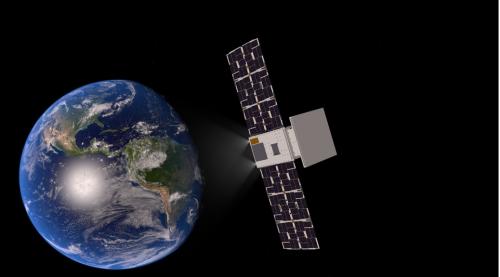What is CAPSTONE?
A microwave oven–sized CubeSat weighing just 55 pounds will serve as the first spacecraft to test a unique, elliptical lunar orbit as part of NASA’s Cislunar Autonomous Positioning System Technology Operations and Navigation Experiment (CAPSTONE). As a precursor for Gateway, a Moon-orbiting outpost that is part of NASA’s Artemis program, CAPSTONE will help reduce risk for future spacecraft by validating innovative navigation technologies and verifying the dynamics of this halo-shaped orbit.

Rocket Lab’s Photon satellite bus will deliver CAPSTONE into a trajectory toward the Moon through a series of orbit raising maneuvers.
The orbit, formally known as a near rectilinear halo orbit (NRHO), is significantly elongated. Its location at a precise balance point in the gravities of Earth and the Moon, offers stability for long-term missions like Gateway and requires minimal energy to maintain. CAPSTONE’s orbit also establishes a location that is an ideal staging area for missions to the Moon and beyond. The orbit will bring CAPSTONE within 1,000 miles of one lunar pole on its near pass and 43,500 miles from the other pole at its peak every seven days, requiring less propulsion capability for spacecraft flying to and from the Moon’s surface than other circular orbits.

Once released from Rocket Lab’s Photon satellite bus, CAPSTONE will use its own propulsion system to travel 3 months before entering into orbit around the Moon.
After a three-month journey to its target destination, CAPSTONE will orbit this area around the Moon for at least six months to understand the characteristics of the orbit. Specifically, it will validate the power and propulsion requirements for maintaining its orbit as predicted by NASA’s models, reducing logistical uncertainties. It will also demonstrate the reliability of innovative spacecraft-to-spacecraft navigation solutions as well as communication capabilities with Earth. The NRHO provides the advantage of an unobstructed view of Earth in addition to coverage of the lunar South Pole.

After arrival at the Moon, CAPSTONE will begin its 6-months long primary mission. CAPSTONE will validate a near rectilinear halo orbit’s characteristics by demonstrating how to enter into and operate while in the orbit.
To test these new navigation capabilities, CAPSTONE has a second dedicated payload flight computer and radio that will perform calculations to determine where the CubeSat is in its orbital path. Circling the Moon since 2009, NASA’s Lunar Reconnaissance Orbiter (LRO) will serve as a reference point for CAPSTONE. The intention is for CAPSTONE to communicate directly with LRO and utilize the data obtained from this crosslink to measure how far it is from LRO and how fast the distance between the two changes, which in turn determines CAPSTONE’s position in space.
This peer-to-peer information will be used to evaluate CAPSTONE’s autonomous navigation software. If successful, this software, referred to as the Cislunar Autonomous Positioning System (CAPS), will allow future spacecraft to determine their location without having to rely exclusively on tracking from Earth. This capability could enable future technology demonstrations to perform on their own without support from the ground and allow ground-based antennas to prioritize valuable science data over more routine operational tracking.
CAPSTONE is scheduled to launch in early 2021 aboard a Rocket Lab Electron rocket from NASA’s Wallops Flight Facility in Virginia. It is expected to be the company’s first launch from Wallops with a NASA payload as well as the second spacecraft to launch to the Moon from Virginia (the first being NASA's Lunar Atmosphere and Dust Environment Explorer mission in 2013). With a highly ambitious schedule, CAPSTONE will demonstrate key commercial capabilities. NASA partners will test cutting-edge tools for mission planning and operations, paving the way and expanding opportunities for small and more affordable space and exploration missions to the Moon, Mars and other destinations throughout the solar system.
Source: U.S. National Aeronautics and Space Administration
- 355 reads
Human Rights
Fostering a More Humane World: The 28th Eurasian Economic Summi

Conscience, Hope, and Action: Keys to Global Peace and Sustainability

Ringing FOWPAL’s Peace Bell for the World:Nobel Peace Prize Laureates’ Visions and Actions

Protecting the World’s Cultural Diversity for a Sustainable Future

Puppet Show I International Friendship Day 2020

